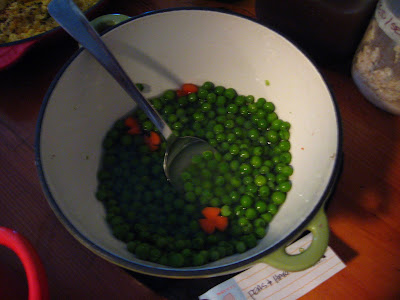
Throughout the retreat, we started to get a little burdened with leftovers. We weren't sure how to use 2 servings of rice, or a tiny bit of left over vegetables, so we started finding creative ways to use them in our cooking. Here's an application for left over grains, especially non-glutinous! Since we had a celiac person in our retreat, I felt a little bothered that all of our bread had gluten in it (kamut) and so began making brown rice sourdough bread. However, as grains ferment in the process, it doesn't really matter what grain it is, and if it's cooked or not. So I began putting grain leftovers in a large bowl to ferment, and would make them into bread. The first morning I made it, I didn't think it was really anything special, as was kinda weird... however, that same morning I happened to drop an entire scalding hot crock pot full of cooked brown rice congee on the ground while carrying it to the dining hall, and it smashed all over the place (including my bare feet, which gave coincidentally gave me a lovely little liver moxibustion treatment), anyways - I felt so bad that I thought I'd better serve this strange congee bread, and low and behold, they ate all of it - 2 full loaves. They loved it, and I continued making it throughout the retreat from then on.
As it really is a tactile thing to make, and working with leftovers really offers no quantifiable, measurable methodology to making it, I just simply add brown rice sourdough starter to the leftover grains (about 1 cup) and then add fluids to bring it to a batter like consistency, maybe a little wetter. For fluids, I would use leftover, starting to ferment homemade brown rice milk, or some left over vegetable cooking water - as it was a little starchier to help the bacteria nosh on the soon-to-be dough. After a day of sitting, or when I see it rise, I add fresh ground brown rice to bring it to batter consistency, and again, add a little fluid if need be. I think some dry ground grain is necessary to make it tough enough to bake, as the cooked grains were too wet and soft to make a loaf unto themselves. As a batter consistency (maybe slightly firmer than batter) pour into loaf pans and let them rise (you can rise as many times as you like, but it MUST rise in the bread pan before baking), and then when risen (usually in the morning) bake it at 450F for at least an hour. It will be extremely wet and doughy when you take it out, so it MUST cool and set IN the pan for at least 1/2 hour or so, and even still, it might pull apart a little, so be sure to grease your pans and get them out carefully. You can check to see if their done without taking them out of the pan simply by inserting a chop stick and checking to see if any doughy residues remain on the stick. You'll know, and it does take practice to get it right. It took me a whole year to get this down, but then again I didn't know what I was doing when I started! Good luck, and email Whole Foodies for questions if you have them!

















